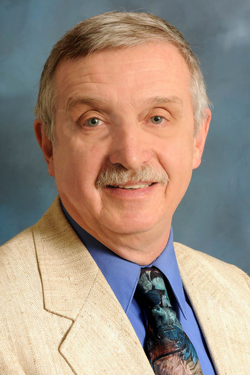Report calls for ‘open exchange of ideas’ to solve a major public health problem of 21st century
June 11, 2013

Dr. James Hébert
Ending the obesity pandemic may require a certain “climate change,” although this change won’t involve discussions on global warming or the impending demise in polar bears.
However, it will involve the creation of a climate that encourages an “open exchange of ideas and redirection of policies that can remove the barriers that prevent us from making material progress in solving a major public health problem of the early 21st century.”
A report, led by Dr. James Hébert of the University of South Carolina’s Arnold School of Public Health, finds that many people, including members of the scientific community, have made assumptions and perpetuated myths about the cause of obesity – and these stand in the way of ending the obesity pandemic.
Published in the June 2013 online version of the Mayo Clinic Proceedings, the report cited three specific factors, each with policy implications that must be overcome in order to treat and prevent obesity.
The first problem is the lack of clarity in defining obesity. For example, physiologists and laboratory scientists define obesity on the basis of the presence of excess fat tissue while clinicians and public health sciences define obesity only on the basis of relative body weight. Second, a broad range of methodological practices are generating data that lead to the misconceptions of obesity’s causes. Because they are constrained by widespread biases in favor of unwarranted assumptions and myths, these tend to reinforce those biases. The third factor addresses scholarly discussions, including peer-review of grants and scientific manuscripts that accept and therefore perpetuate unwarranted assumptions about obesity’s causes without accurate models or adequate evidence.
Obesity generally is defined as having a Body Mass Index (BMI) of 30kg/m2 or more, said Hébert of the Arnold School’s Cancer Prevention and Control Program and a professor in the Department of Epidemiology and Biostatistics.
“Even when body fat is considered the main factor in determining its definition, obesity is not a single pathologic condition,” he said.
Obesity can be better understood by considering specific differences among people with high BMIs, and looking at the interplay of the external environment, which includes the availability of food, the built environment, social and cultural factors, with individual differences in genetics, energy expenditure, and nutrient partitioning.
The confusion and controversy are amplified even more by the “obesity paradox,” which has shown that some overweight and obese people with cardiovascular diagnoses have better short- and long-term than their leaner counterparts, Hébert said.
Even within the scientific community, the researchers had concerns.
“Despite that obesity may not simply be the result of overeating, numerous journals continue to publish articles suggesting that the superficial economics (e.g., availability of cheap “junk” food) has caused the obesity epidemic,” they wrote in the article.
“Maintaining assumptions without having a factual foundation does not advance the scientific understanding of obesity, which is portrayed as the evil enemy,” Hébert said.
Future research should accommodate the complexity of the obesity problem. To address the public health problems, some studies must be conducted in the context of how people live their lives, said Hébert, noting that self-reporting of diets and physical activity in studies may need further examination and refinement in order to meet the challenge.
“Widely used self-reports are often subject to large sources of measurement bias,” he said.
The current rates of obesity and related conditions take a toll on health care resources and reduce productivity enjoyment of life. “The scientific community must demand higher standards to understand obesity’s causes and potential solutions,” said Hébert.
The research team for the report also included Dr. Steve Blair and Dr. Ed Archer from the Arnold School, Dr. David B. Allison of the University of Alabama School of Public Health and Dr. Carl J. Lavie of the University of Queensland School of Medicine, New Orleans, and the Pennington Biomedical Research Center.
A video featuring an interview with Dr. Hébert is available:
www.youtube.com/watch?v=7e00RUt2tHI&list=PLcFM5N99WwbncruwAJtw9c6lp3Osl1QE6



_01.jpg)
_02.jpg)